Stock Market Support is Now Resistance
Stock-Markets / Stock Markets 2010 Jun 19, 2010 - 06:59 AM GMT (The Atlantic) On the third floor of Citigroup’s Manhattan headquarters, at the far end of a trading floor overlooking the Hudson River, Young Kang, Citi’s global head of algorithmic products, leans over a terminal and monitors the progress of a canny and powerful beast named Dagger. Bred and trained in secret by Citi’s financial engineers, Dagger can stalk through more than 20 markets, public and otherwise—hunting for anomalies, buying and selling, prowling through mountains of historical data—all at the behest of Citi’s clients. Amid the trading-floor din, Dagger fulfills its duties in flickering silence, with a speed and acuity no human can match.
(The Atlantic) On the third floor of Citigroup’s Manhattan headquarters, at the far end of a trading floor overlooking the Hudson River, Young Kang, Citi’s global head of algorithmic products, leans over a terminal and monitors the progress of a canny and powerful beast named Dagger. Bred and trained in secret by Citi’s financial engineers, Dagger can stalk through more than 20 markets, public and otherwise—hunting for anomalies, buying and selling, prowling through mountains of historical data—all at the behest of Citi’s clients. Amid the trading-floor din, Dagger fulfills its duties in flickering silence, with a speed and acuity no human can match.
“It’s self-learning,” Kang says. “The numbers keep updating, the strategy keeps adjusting itself. It gets smarter.” And it makes a lot of money.
Employment numbers soar as Government Hiring picks up a lot of slack.
Regional and state unemployment rates were slightly lower in May. Thirty-seven states and the District of Columbia recorded unemployment rate decreases over the month, 6 states had increases, and 7 states had no change, the U.S. Bureau of Labor Statistics reported today. Thirty-one states and the District of Columbia posted unemployment rate increases from a year earlier, 17 states recorded decreases, and 2 states had no change. The national jobless rate edged down by 0.2 percentage point to 9.7 percent, but was up from 9.4 percent in May 2009.
A noteworthy item is, out of 394 thousand jobs created in May, 86% was courtesy of government hiring. This is not surprising as the bulk of the hiring was due to census, as was already reported. Losses were reported in Construction, Trade, Transportation, Financial Services, and Education and Health Services. Gains were seen in manufacturing, professional and leisure and hospitality services.
Support…is now resistance?
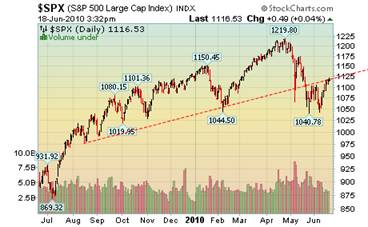 --Market behavior may often be visualized through trendlines, which often show up in my charts. This week’s rally extended a little higher than its predecessor, giving confidence to those who are looking for a “bullish breakout.” However, the trendline that marked market bottoms (support) since last August may prove to mark the top of this rally. It is called resistance.
--Market behavior may often be visualized through trendlines, which often show up in my charts. This week’s rally extended a little higher than its predecessor, giving confidence to those who are looking for a “bullish breakout.” However, the trendline that marked market bottoms (support) since last August may prove to mark the top of this rally. It is called resistance.
Treasury bond formation signals continuation of the rally.
 -- The triangle pattern you see in the chart is a pretty strong continuation pattern. In other words, the rally may live on for a while. One might also note that the rally in bonds coincided well with the decline in stocks. A breakout above the triangle formation in Treasury bonds may have similar consequences again for stocks.
-- The triangle pattern you see in the chart is a pretty strong continuation pattern. In other words, the rally may live on for a while. One might also note that the rally in bonds coincided well with the decline in stocks. A breakout above the triangle formation in Treasury bonds may have similar consequences again for stocks.
Gold broke out to a new high today.
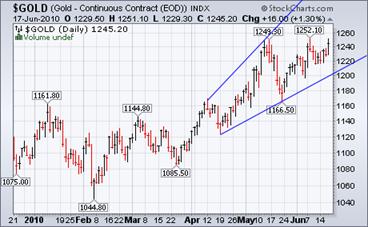 -- Gold broke out to a new all-time high of 1263.70 today. The metal has climbed more than 15 percent this year, outperforming equities and bonds, while the euro slumped 14 percent. A majority of Greeks believe the country may go bankrupt, an opinion poll showed. Spain has 24.7 billion euros of maturing debt in July and may need to use a financial lifeline from the European Union.
-- Gold broke out to a new all-time high of 1263.70 today. The metal has climbed more than 15 percent this year, outperforming equities and bonds, while the euro slumped 14 percent. A majority of Greeks believe the country may go bankrupt, an opinion poll showed. Spain has 24.7 billion euros of maturing debt in July and may need to use a financial lifeline from the European Union.
Nikkei reverses at bear market levels.
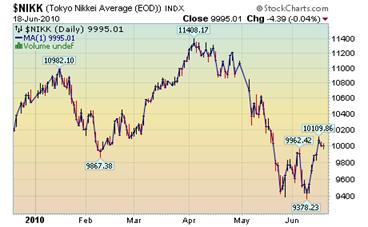 -- Japanese stocks fell with consumer lenders sliding and dragging down banks as a stricter lending rule clouded earnings prospects. Softbank Corp. and Daikin Industries Ltd. climbed on analysts’ ratings. The Nikkei 225 Stock Average lost 0.04 percent to 9,995.02, trimming its weekly gain to 3 percent. The Japanese economy is living on borrowed time and cutting consumer lending will slam the brakes on earnings.
-- Japanese stocks fell with consumer lenders sliding and dragging down banks as a stricter lending rule clouded earnings prospects. Softbank Corp. and Daikin Industries Ltd. climbed on analysts’ ratings. The Nikkei 225 Stock Average lost 0.04 percent to 9,995.02, trimming its weekly gain to 3 percent. The Japanese economy is living on borrowed time and cutting consumer lending will slam the brakes on earnings.
China stocks are down over 20%.
 -- China’s stocks fell the most in three weeks as pharmaceutical, technology and consumer companies slumped on concern valuations are excessive given the prospect of further monetary tightening and slowing economic growth. The Shanghai Composite Index dropped 47.02, or 1.8 percent, to close at 2,513.22, after touching its lowest level since April 2009. The decline was the biggest since May 31 and capped a 2.2 percent loss for the week, when China’s markets were shut for the first three days.
-- China’s stocks fell the most in three weeks as pharmaceutical, technology and consumer companies slumped on concern valuations are excessive given the prospect of further monetary tightening and slowing economic growth. The Shanghai Composite Index dropped 47.02, or 1.8 percent, to close at 2,513.22, after touching its lowest level since April 2009. The decline was the biggest since May 31 and capped a 2.2 percent loss for the week, when China’s markets were shut for the first three days.
The dollar gets ready for its next big move.
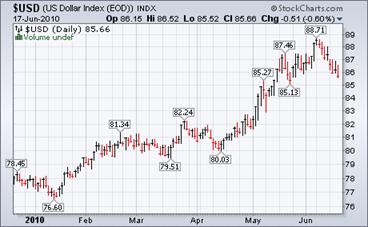 -- The two week-old decline in the dollar now has the media focusing on the Euro, instead. The automatic assumption is that the Euro will recover and the dollar will decline. This has prompted traders to buy the Euro and sell the dollar. But the promises of the never-ending bailout ring more hollow by the day. The Euro rally won’t last. The dollar will regain its supremacy…for now.
-- The two week-old decline in the dollar now has the media focusing on the Euro, instead. The automatic assumption is that the Euro will recover and the dollar will decline. This has prompted traders to buy the Euro and sell the dollar. But the promises of the never-ending bailout ring more hollow by the day. The Euro rally won’t last. The dollar will regain its supremacy…for now.
Housing Market Slows as Buyers Get Picky
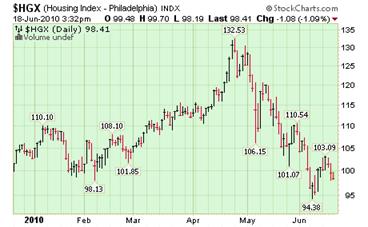 --Before the recession, people simply looked for a house to buy. Later they got squeamish just thinking about buying. Now they are on a quest for perfection at the perfect price.
--Before the recession, people simply looked for a house to buy. Later they got squeamish just thinking about buying. Now they are on a quest for perfection at the perfect price.
Exacting buyers are upending the battered real estate market, agents and other experts say, leading to last-minute demands for multiple concessions, bruised feelings on all sides and many more collapsed deals than usual.
EIA needs a new script writer.
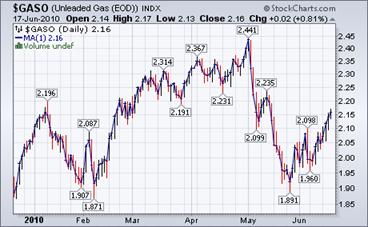 The Energy Information Agency weekly report observes, “The U.S. average price for regular gasoline has declined for five consecutive weeks. Prices dropped by over 2 cents to hit $2.70 per gallon, 3 cents higher than a year ago. Over the last five weeks, the price for regular gasoline has decreased by over 20 cents per gallon.”
The Energy Information Agency weekly report observes, “The U.S. average price for regular gasoline has declined for five consecutive weeks. Prices dropped by over 2 cents to hit $2.70 per gallon, 3 cents higher than a year ago. Over the last five weeks, the price for regular gasoline has decreased by over 20 cents per gallon.”
Natural Gas prices seeing downward pressure.
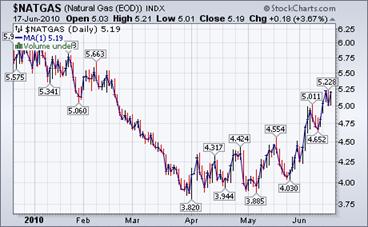 --. The U.S. Energy Information Administration reports, “Continuing an overall upward trend, natural gas spot prices rose this week, likely in response to the summer-like temperatures across much of the country and increasing crude oil prices. The increase in cooling demand in many areas of the country put upward pressure on spot prices this week. The largest price hikes occurred at trading locations that serve markets in Florida.”
--. The U.S. Energy Information Administration reports, “Continuing an overall upward trend, natural gas spot prices rose this week, likely in response to the summer-like temperatures across much of the country and increasing crude oil prices. The increase in cooling demand in many areas of the country put upward pressure on spot prices this week. The largest price hikes occurred at trading locations that serve markets in Florida.”
Consumer price index 'inflation report' shows deflation.
The overall level of US consumer prices fell in May for the second month in a row, a sign that the economic recovery remains weak. Normally people call this monthly bulletin the "inflation report." Now the consumer price index (CPI) shows deflation at least since January.To some forecasters, this signals the risk of dip back into recession in the US. Or, more likely, it means that central banks will be keeping interest rates low for many months to come – perhaps even into 2012.
Bornon Third Base.
Barry Switzer, the former head coach at the University of Oklahoma, once said "Some people are born on third base, and go through life thinking they've hit a triple." Among the fascinating aspects of the recent economic "recovery," probably the greatest is the failure of analysts to understand that this growth is none of the private sector's doing.
Wall Street seems to have no concept at all that every bit of growth we've observed over the past year can be traced to government deficit spending, with zero private sector expansion when those deficits are factored out. As I noted last week, if one removes the impact of deficit spending, "the economy has recovered to the point where the year-over-year growth rate since early 2009 now matches the worst performance of any of the 50 years preceding the recent downturn." In effect, Wall Street's is seeing "legs" where the economy is in fact walking on nothing but crutches.
Traders alert: The Practical Investor is currently offering the daily Inner Circle Newsletter to new subscribers. Contact us at tpi@thepracticalinvestor.com for a free sample newsletter and subscription information.
Our Investment Advisor Registration is on the Web
We are in the process of updating our website at www.thepracticalinvestor.com to have more information on our services. Log on and click on Advisor Registration to get more details.
If you are a client or wish to become one, please make an appointment to discuss our investment strategies by calling Connie or Tony at (517) 699-1554, ext 10 or 11. Or e-mail us at tpi@thepracticalinvestor.com .
Anthony M. Cherniawski, President and CIO http://www.thepracticalinvestor.com
As a State Registered Investment Advisor, The Practical Investor (TPI) manages private client investment portfolios using a proprietary investment strategy created by Chief Investment Officer Tony Cherniawski. Throughout 2000-01, when many investors felt the pain of double digit market losses, TPI successfully navigated the choppy investment waters, creating a profit for our private investment clients. With a focus on preserving assets and capitalizing on opportunities, TPI clients benefited greatly from the TPI strategies, allowing them to stay on track with their life goals
Disclaimer: The content in this article is written for educational and informational purposes only. There is no offer or recommendation to buy or sell any security and no information contained here should be interpreted or construed as investment advice. Do you own due diligence as the information in this article is the opinion of Anthony M. Cherniawski and subject to change without notice.
Anthony M. Cherniawski Archive |
© 2005-2022 http://www.MarketOracle.co.uk - The Market Oracle is a FREE Daily Financial Markets Analysis & Forecasting online publication.



